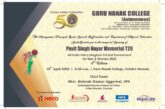India joined the Earth Hour movement in 2009, where 5 million Indians across 56 cities, 100 top public and private sector organizations, and local governments participated and saved approximately 1000 MW of power in that hour. Every year, Earth Hour in India reaches new heights of participation, and in 2011, citizens across 130 Indian cities switched off and committed to a low carbon lifestyle. A team within WWF-India coordinates with partners and supporters, uniting individuals, governments, and organizations in support of the global movement.
WWF-India’s beginnings were modest. Operating out of a limited office space at the Horn Bill house in Mumbai and with very few full-time staff, it relied largely on the goodwill of the close-knit group of its founders, and other associates who voluntarily contributed their time and resources to the work of the organization.
WWF-India took on and supported field projects aimed at protecting endangered species of flora and fauna; initiated the country’s first large-scale education and awareness programme (through Nature Clubs) public awareness of wildlife and nature conservation; and raised conservation funds through appeals, campaigns, educational product sales, and so on.
Throughout the seventies and eighties, WWF-India kept its focus on wildlife and nature conservation. It would be near impossible to list out all its projects and other activities in the field of wildlife, but just to cite a few pioneering examples.In the early seventies, WWF-India led a very successful campaign to save the Great Indian Bustard, in the face of the hunting forays of some invited guests.
The protest led to the Government reversing its permission for the hunting expedition.It provided the seed grant for establishing the Madras Snake Park in 1971, and again in 1975, helped establish the country’s first Crocodile Bank in collaboration with the Snake Park Trust.
In 1976, it sent an expedition led by Dr. Salim Ali, to Ladakh, to establish the status of the rare Blacknecked Crane. In 1980, the Sea Turtle Conservation Project was launched.
A whole host of other Indian species have received attention from time to time. Among these are the Wolf, the Andaman Teal, the Hispid Hare, the Pygmy Hog, the Flamingoes of Kachchh, the lesser Cats, the Greater Adjutant Stork in Assam, the Hangul in Kashmir, and the Lion-tailed Macaque, to name just a few.
More recently, there have been projects relating to the Asiatic Lion, the highly endangered Himalayan Newt, the Red Panda, the Mountain Quail, the Pheasants, the Great Indian Bustard, and several other species. Of course, conservation of the tiger and its habitats has been high on the agenda right from the beginning.
Right from the inception of Project Tiger, WWF-India has been involved with the project in an advisory capacity. Several of WWF-India’s Trustees – eminent conservationists in their own right – have been on the Project Tiger Steering Committee, the Indian Board for Wildlife, and other national apex bodies for wildlife conservation.
The organization was also instrumental in securing the future of several tiger habitats and other wilderness areas, through lobbying at the highest levels. Among the significant ones are: the Dalma Hills (1976) and the Gautama Buddha Sanctuaries (1978) in Bihar, the Eravikulam-Rajamalai in Kerala to protect the Nilgiri Tahr, and the country’s first Marine National Park in the Gulf of Kachchh. It was also in the forefront of the campaigns to save the world-famous Silent valley from a proposed hydroelectric project and have it established as a National Park.
In 1984, its recommendation to notify Buxa in north Bengal as a Tiger Reserve was accepted. The Government of Assam acted on a similar proposal and in 1986, established the Dibru-Saikhowa Sanctuary. Other campaigns have led to the establishment of the Delhi Wildlife Sanctuary, Mansarovar Lake and Dodai Lake Sanctuaries, Balpakhram Sanctuary in Meghalaya. WWF-India has also been engaged in legal activism to secure the future of a number of sensitive wildlife areas, including Bhittarkanika in Orissa, Narayan Sarovar in Gujarat, and the Delhi Ridge forest.
Another notable area of the organization’s work is the monitoring of wildlife trade through the TRAFFIC-division. It has ably assisted the enforcement agencies over a number of years, in the work of field investigations, raids and seizures, enforcement training, and field studies. It has made notable contributions in the field of live bird trade, ivory, edible swiftlet nests, sandalwood, shahtoosh, pangolin, musk, bear bile, tiger parts, and rhino horn. One of the recent successful campaigns using both print and electronic media is captioned “Don’t Buy Trouble” and targets potential customers of illegal wildlife products.
Today, WWF-India is not only the country’s largest voluntary body in the field of conservation, it has also grown into a network with a countrywide presence, It has taken on diverse activities in the field of nature protection – ranging from education and capacity building, to field projects in biodiversity, to enviro-legal action, to policy studies and advocacy, to even areas such as religion and conservation.
For the first time in human history, most people live in cities, and our urban lifestyle is taking a huge toll on our planet. But through collective action from local citizens, our cities can make a huge difference in reducing their impact on the environment.So this Earth Hour, take action for your city by switching off lights on Saturday, 31st March 8:30 – 9:30 PM and make your city an Earth Hour Champion!
6 mega cities- Delhi, Mumbai, Kolkata, Chennai, Hyderabad, and Bangalore– have registered in the race to become the Earth Hour 2012 Champion City! These cities are taking meaningful steps to encourage participation for Earth Hour and build a green community within their city. Is your city gearing up to participate?
Lead the way for your entire city, making sure you and your fellow citizens collectively participate in Earth Hour to make your city the Earth Hour Champion!




